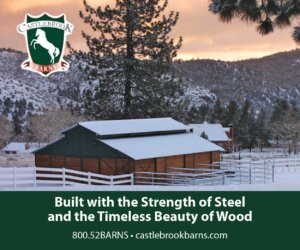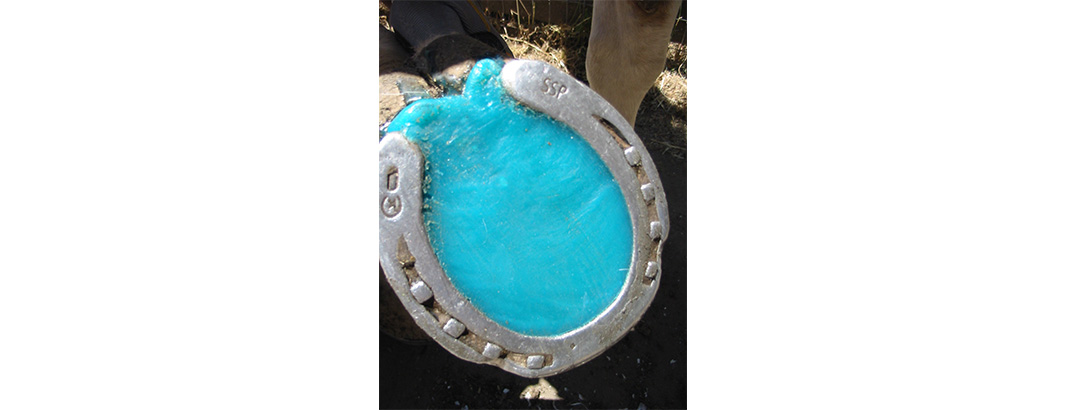by Tab Pigg
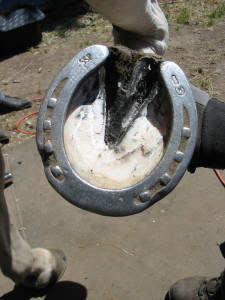 In the spring, the wet climate, punctuated by ample rain, sets the stage for thrush to run rampant through the barn. Thrush is a bacterial infection that resides in the soft tissue of the frog. The moist environment, combined with manure and mud, create unsanitary conditions in the stall, and dirt, debris and other bacteria get trapped in the frog. If horses hooves are not picked out on a daily basis, thrush sets in and it can be difficult to conquer. And, when a horse has beginning stages of thrush, it probably won’t even show lameness symptoms unless the infection becomes more severe.
In the spring, the wet climate, punctuated by ample rain, sets the stage for thrush to run rampant through the barn. Thrush is a bacterial infection that resides in the soft tissue of the frog. The moist environment, combined with manure and mud, create unsanitary conditions in the stall, and dirt, debris and other bacteria get trapped in the frog. If horses hooves are not picked out on a daily basis, thrush sets in and it can be difficult to conquer. And, when a horse has beginning stages of thrush, it probably won’t even show lameness symptoms unless the infection becomes more severe.
The Anatomy of Thrush
When looking at a horse’s foot from the bottom, the hoof wall circles from the outside heel around the point of the toe, and on to the inside heel. The frog is a dark-colored soft tissue that is triangular in shape, and stretches from the heel to midway toward the toe. Because the frog and hoof wall bear equal weight, the frog is always touching the ground when a horse is standing, thus, bacteria collects in the frog and remains trapped if not cleaned out on a regular basis.
Thrush thrives under conditions where there is minimal oxygen. The preliminary sign of the condition is a strong odor coming from the hoof. Thrush is composed of many different types of anaerobic bacteria and usually resides in the soft tissue of the frog. If a horse is barefoot or unshod, the hooves are usually self-cleaned as a horse moves around and runs, because the debris can escape the hoof cavity more easily. With a shod horse, it is harder for bacteria to escape. And if a horse has a silicone pad product applied, bacteria can get trapped underneath the pad.
Managing Thrush 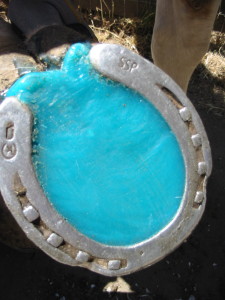
Traditional methods of managing thrush have changed over time. One evergreen approach for preventing and managing thrush is to clean the frog out on a daily basis, and sometimes more often than that. This is something that is often neglected, but very important for horse owners to pay attention to. Depending on the severity of the condition, there may have to be medical attention with a scrub or topical ointment.
The use of pads (plastic and leather) with silicone or other packing material underneath can lead to thrush problems as well. If the area underneath the pad is not completely sealed, moisture and debris can migrate to the sole creating thrush issues.
Newer pour-in pad materials adhere to the bottom of the foot sealing out moisture and debris avoiding this problem. Vettec’s Equi-Pak CS will bond to the bottom of a horse’s foot, eliminating the possibility of bacteria being trapped and causing an infection. EquiPak CS is a fast-setting soft instant pad material, and is infused with copper sulfate to effectively manage mild and moderate cases of thrush. Equi-Pak CS provides extra protection and support during wet seasons, and also bonds to the sole eliminating the need to pick out the feet and apply daily medication. It is also an effective, preventative measure for thrush.
Managing and preventing thrush helps to avoid lameness. Using a pour-in pad is a good way to limit the occurrences of thrush. Advantages of pour-in pad materials include:
• it immediately bonds to the sole, sealing out moisture and debris
• pour-in pad material can be filled to ground level for maximum support and effectively absorbs concussion, instead of sending it up the leg like silicone products
• it supports the boney column by loading the entire solar surface with a pour-in pad, but also positions the weight-bearing load over the entire ground surface and not just the wall
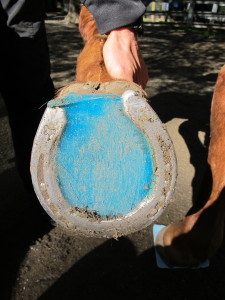 Conclusion
Conclusion
Managing a horse’s thrush can be challenging and tedious, and it’s important to have a good care team to diagnose and oversee the condition to ensure recovery. When considering care options, choose options that help eliminate the chance of bacteria getting trapped in the frog, and one that will also provide support to the horse’s hoof. Using liquid pad technology, veterinarians and farriers now have the ability to use materials that will bond to the foot, withstand the weight of the horse and help protect against debris and bacteria from entering the hoof’s internal cavity.
Tab Pigg is a Certified Journeyman Farrier and Farrier-at-Large for Vettec Inc., a manufacturer of innovative sole support products for horses. In his role at Vettec, Tab leads hands-on clinics throughout the U.S. to teach shoeing and forging techniques to equine owners, farriers, and veterinarians. He also visits veterinary and farrier schools exchanging information about hoof anatomy and shoeing. Tab shares his expertise via a popular video and blog series,“Two Minutes with Tab” on Vettec.com For Tab, shoeing horses is much more than a way to earn a paycheck. Helping horses and knowing that he has the ability to improve the horse’s quality of life is very valuable to him. Tab lives his own motto every day: “The education to become a farrier never ends. Anyone who feels that they have it all figured out is wrong.”


